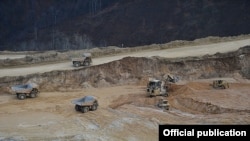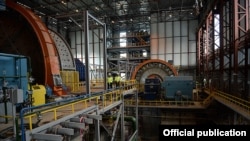Overcoming fierce resistance from environmentalists, a private mining company has officially launched production operations at Armenia’s second largest copper deposit that will significantly increase output in the main export-oriented sector of the Armenian economy.
Vallex Group inaugurated at the weekend an ore-processing plant which it has built at the Teghut forest in the northern Lori province as part of a $380 million project to mine copper and molybdenum there.
President Serzh Sarkisian underlined the Armenian government’s strong support for the controversial project with his presence at the opening ceremony. It took place just three weeks after the government gave the final green light to a British company planning to develop untapped gold reserves of Armenia.
Armenian environment protection groups have for years tried to scuttle the Teghut project, saying that it would wreak more havoc on the country’s green areas that have shrunk dramatically since the 1990s.
Open-pit mining at Teghut will lead to the destruction of 357 hectares of rich forest, including 128,000 trees. Vallex Group has pledged to offset this damage by planting twice as many trees in adjacent areas and thus creating a new and bigger forest. It has also denied environmentalists’ claims that ore crushing and enrichment will pollute a local river and underground waters.
Vallex, which also mines copper elsewhere in Lori as well as in Nagorno-Karabakh, has also emphasized the project’s socioeconomic significance for Armenia. It claims to have created about 1,300 new jobs and has pledged to build new schools and upgrade infrastructure in nearby villages.
Critics dismiss these assurances, arguing, among other things, that the company has failed to modernize its Soviet-era copper smelter located in Alaverdi, a Lori town notorious for its polluted air and high incidence of grave diseases.
Vallex, which is run and at least partly owned by Russian-Armenian businessman Valeri Mejlumyan, claims to have already invested almost $340 million in Teghut. It has borrowed the bulk of that money from VTB, a leading Russian bank.
The company also attracted last year $62 million in funding from a Danish pension fund which was due to be partly or fully channeled into purchases of metallurgical equipment. Earlier in 2013, the Armenian government agreed to delay by three years the collection of 20 percent value-added tax from some of that equipment.
The Teghut forest lies atop ore deposits containing an estimated 1.6 million tons of copper and about 100,000 tons of molybdenum. In a statement posted on its website, Vallex said that it plans to manufacture $182 million worth of non-ferrous ore concentrates there already in 2015.
By comparison, output in Armenia’s interconnected mining and metallurgy sectors totaled $300 million in January-October 2014, according to government data. The figure was equivalent to almost 29 percent of overall Armenian industrial production. Base metals and enriched ores also accounted for nearly half of Armenian exports which stood at $1.25 billion in the ten-month period.
The sectors’ combined export revenue was down by roughly 5 percent year on year, reflecting a more than 10 percent fall in the international price of copper registered since January.
The price of gold, another major Armenian export item, has also fallen considerably since the beginning of 2013. Nevertheless, Armenian gold exports rose by 10 percent to almost $60 million in January-September 2014, according to the national customs service. In physical terms, they were up by as much as 49 percent, at 2.77 metric tons.
Armenia’s largest gold mines are operated by a Russian company, GeoPro Mining. The latter claims to have made $140 million in capital investments in the Sotk mines in the eastern Gegharkunik province and a smelter located in the southern town of Ararat since 2011.
Gold production in the country should rise further after the forthcoming launch of mining operations at the smaller Amulsar deposit in the southeastern Vayots Dzor province. Lydian International, a British company, plans to invest more than $400 million in the operation. The Armenian Ministry of Environment Protection gave its final approval to the project early this month.
“Lydian intends that Amulsar will become an exemplary mining and investment project in Armenia,” Howard Stevenson, the company chairman, said in a December 2 statement. He said at least 700 people will work at Amulsar for the next ten years.
The Amulsar project has also sparked protests from Armenian environmentalists. They cite its proximity to Jermuk, the country’s largest and most famous spa resort.
Lydian has repeatedly sought to dispel these concerns, saying that it will use advanced technology and strictly adhere to environmental safety standards.







